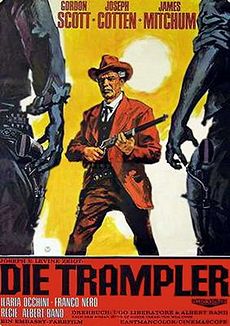The Tramplers Review
This page is **** Under Construction **** Please return later

|
| THE TRAMPLERS (1965) |
Cast:
Director:
|
The Tramplers (Gli Uomini dal Passo Pesante)
The second spaghetti baby of writer/producer/director Albert Band, an Italian expatriate born as Alfredo Antonioni. His first spaghetti western, Massacre at Grand Canyon, had been co-directed by Sergio Corbucci. This movie is presented as ‘a film by Albert Band, directed by A. Whileys’, but Giusti thinks Antonini was the only director (1). Whileys was a pseudonym of the little-known director Mario Sequi, and his name was probably only used for the so-called quota (2). It’s also a sort of twin movie of The Hellbenders, written and produced by Antonini, but directed by Sergio Corbucci. Both movies use story elements from the same novel, Guns of North Texas by Will Cook. In both movies Joseph Cotton plays a Southern patriarch who refuses to give up the fight after Lee had surrendered to Grant.
Corbucci would turn the character into a lunatic, but with Antonini in the directional chair, he’s a more tragic figure, a sort of local Ben Cartwright (he has five sons!) who desperately tries to cling to the traditions that are irrevocably lost. In a post-war Texas, he is still fighting his private war, taking the law into his own hands, hanging everybody who infringes upon his authority: thieves, robbers, carpetbeggars, slaves, you name it (he has no shortage of rope, as we are told by one of the characters). In the opening scene, we see him hanging a newspaper man who has told the black people on his ranch that they’re no longer slaves. The scene is witnessed by the hanged men’s daughter (who wants to put Cordeen on trial) and Cordeen’s oldest son Lon, who comes back from the war and is appalled by the hanging (and attracted to the hanged man’s daughter). Lon tries to talk some reason into his father and his brothers first, but things go from bad to worse when one of the younger brothers, who’s had enough of the killings, turns against the rest of his family and the youngest daughter decides to follow her heart against her father’s wishes.
With story elements like the adamant patriarch and the prodigal son causing discord in the domestic circle, Antonini tries to create a Biblical atmosphere of fatality and doom. Some have also noticed similarities to Spanish so-called ‘Saturn tragedies’ about fathers who’d rather kill their own children than accept the desintegration of the family (3). Of the two movies based on Will Cook’s novel, this one has the better script, but Antonini is no Corbucci. Thanks to a decent storyline, The Tramplers is watchable, but that’s about it: it’s a watchable early spaghetti western, with some historic relevance, but it’s mediocre in nearly all departments. Although the Cordeens are ranchers, it’s also a rather town-bound western. Not only Temple Cordeen is a sort of local Ben Cartwright (one who has fallen from grace), the entire movie feels like a protracted episode of Bonanza. There’s still some confusion as to where the outdoor scenes of a cattle drive (the Rawhide effect) were shot. Some think Argentina, but according to Christopher Frayling, Antonini had acquired some footage of gauchos driving a huge herd of cattle through the Argentine pampas and integrated the material into his film (4). For this reason the cast members never appear in the same scenes as the Argentine cattle.
Gordon Scott (the Tarzan factor), in his last screen appearance, isn’t very convincing as Lon, the prodigal son, but Joseph Cotton turns in a very decent performance as the tragic patriarch and James Mitchum is much better in this movie than in his first spaghetti western, Massacre at the Grand Canyon. It’s also nice to see Franco Nero in his pre-Django days, but his role as the suave lover of the rebellious daughter isn’t exactly memorable. Thanks to the presence of Cotton, Scott and Mitchum the movie was released theatrically in North America, where it was presented as ‘the first genuine large-scale American western to be made in Europe’ (in reality there was no American involvement). The action scenes are unspectacular, with all victims dying the same way, covering their faces after they are shot (Oh, my God, who’s going to look after my wife and kids now?). However, there are a couple of scenes – like Mitchum shooting a few wounded men in the back - that are remarkably violent for an early spaghetti western.
Notes:
- (1) Marco Giusti, Dizionario del Western all’italiano
- (2) In order to receive state subsidies, a production had to meet with specific requirements in relation to the nationality of the people involved. The law (Legge Corona) was changed repeatedly, but until 1972 (when it was stipulated that the production had to be 100 % Italian) a production needed at least an Italian director or co-director in order to receive funds. Antonini was born in Paris and had an American passport. See also A Man Called Sledge Review, note 1.
- (3) The name refers to one of Goya’s paintings, Saturn devouring his Son. It’s part of the series of so-called Black Paintings, that Goya painted directly onto the walls of his house, Quita del Sordo (Villa of the Deaf Man), on the banks of the Manzanares river, outside Madrid. Goya had bought the house because he had become hard-hearing (and eventually deaf) after contracting a fever. The works were painted between 1819 and 1823 when Goya was at high age. The political situation in his home country and a series of illnesses had turned him into an embittered man. Goya also was afraid to become insane. The Black Painting belong to the most devastating works of art in the history of mankind. See also: http://en.wikipedia.org/wiki/Black_Paintings
- Christopher Frayling, Once upon a Time in the Italian West
--By Scherpschutter



